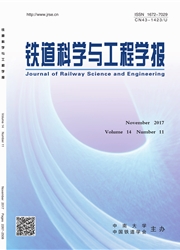

 中文摘要:
中文摘要:
在介绍严寒地区铁路冰雪飞溅危害基础上,利用空气动力学仿真手段分析研究铁路道床表面冰雪飞溅现象。采用不可压缩三维定常雷诺时均方程(RANS)结合k—ε双方程湍流模型分析不同砟肩高度下强列车风对道床表面的气动特性影响。研究结果表明:列车风速越大,道床表面风压越大,越易引起冰雪飞溅;相同风速下,钢轨两侧轨枕槽内监测点风压值最小为4~15Pa,线路中心处监测点风压值约为其10倍,砟肩处监测点风压值约为其25倍,最易引起冰雪飞溅;砟肩高度每增加50mm,风压值增幅为2%~7%。高速铁路冰雪飞溅主要通过列车、线路结构优化,站场除雪等综合治理措施来防治。
 英文摘要:
英文摘要:
On the basis of systemically introducing the railway snow flying hazards on cold regions of the world, the railway track bed snow flying phenomenon is analyzed according to the aerodynamics simulation tools. By adopting 3 - D steady incompressible Reynolds averaged equations (RANS) combined with k - ε two - equation turbulence model, the aerodynamic characteristics of the track bed with strong wind influence is studied. The study found that: the higher train wind speed is, the greater the track bed surface pressure will appear, and the more easily snow splash will caused; Under the same wind velocity, sleepers tank monitoring points pressure on both sides of the rail is 4 Pa to 15 Pa, and the monitoring points pressure at the center of line is about 10 times than that of tank monitoring points, the ballast shoulder monitoring points pressure is about 25 times so that ballast shoulder is most likely caused snow splash; Ballast shoulder pressure vary with ballast shoulder height when ballast shoulder height increases 50 mm the pressure increases by 2% to 7%. The high - speed railway snow flying control measures are : optimization of train and track structure, mechanical snow removal, and comprehensive station integrated management measures.
 同期刊论文项目
同期刊论文项目
 同项目期刊论文
同项目期刊论文
 期刊信息
期刊信息
